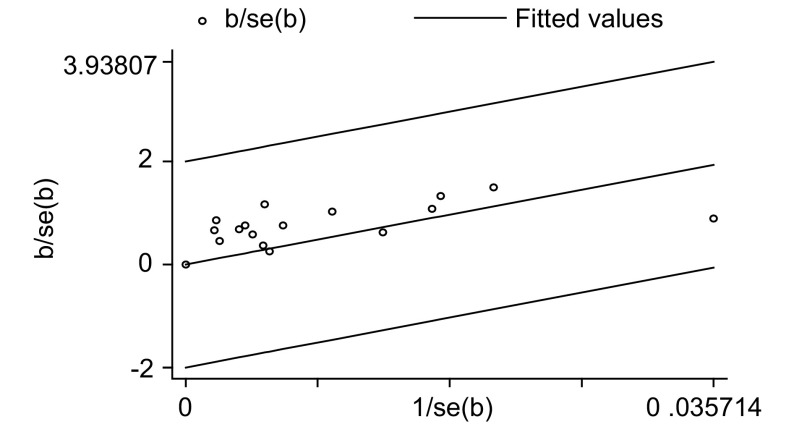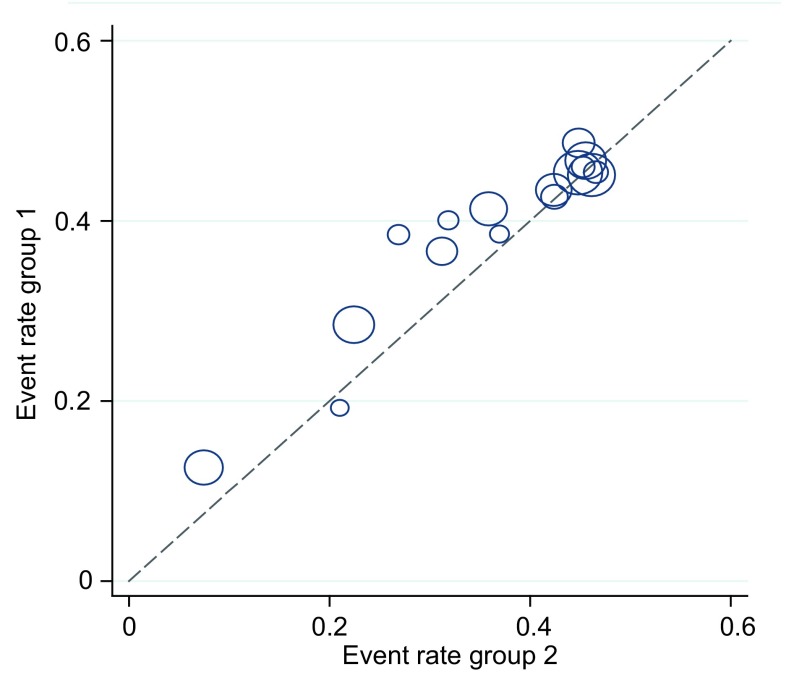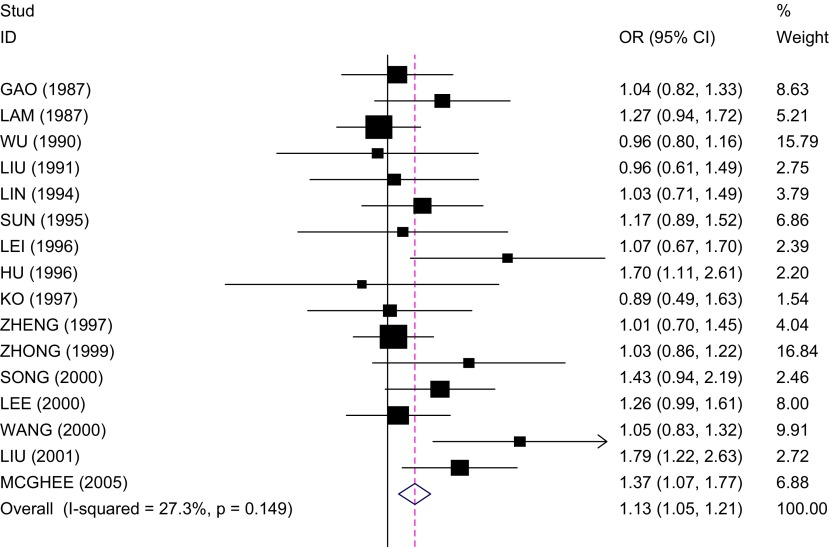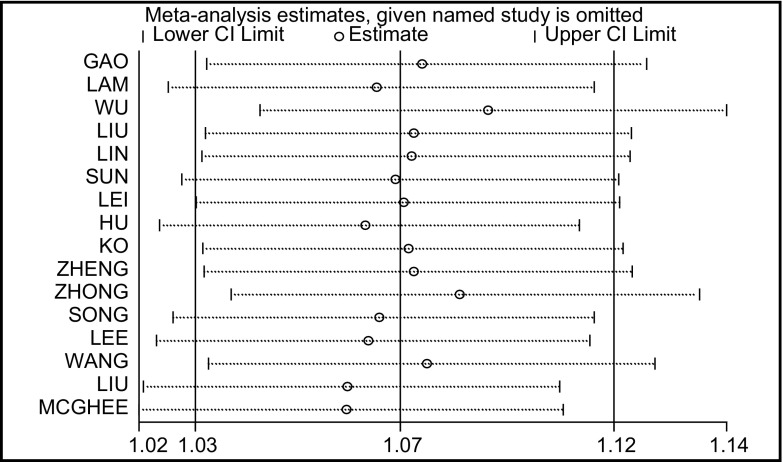Abstract
背景与目的
本研究旨在探讨中国非吸烟人群被动吸烟与肺癌的关系。
方法
通过计算机检索Medline、PubMed、CENTRAL(the Cochrane central register of controlled trials)、中国生物医学文献数据库系统(CBM)、中国期刊全文数据库(CNKI)、中文科技期刊全文数据库(VIP)等收集国内外1987年-2007年间公开发表的关于中国非吸烟人群被动吸烟与肺癌的研究文献,应用统计软件Stata 11.0进行数据分析,计算其合并优势比(odds ratio, OR)和95%置信区间(confidence interval, CI)。采用Begg和Egger法对发表偏倚进行量化检测。
结果
纳入分析的文章共有16篇,合并分析结果表明:中国非吸烟人群被动吸烟与肺癌的关系有统计学意义(OR=1.13, 95%CI: 1.05-1.21, P=0.001)。每日被动吸烟≥20支、成年时期被动吸烟、非吸烟女性被动吸烟、被动吸烟暴露于工作环境等与肺癌的发生关系具有统计学意义,P值、OR值及95%CI分别为:P=0.000 3、OR=1.78、95%CI: 1.30-2.43,P=0.000 1、OR=1.50、95%CI: 1.23-1.83,P=0.000 7、OR=1.50、95%CI: 1.19-1.90,P < 0.000 1、OR=1.41、95%CI: 1.19-1.66。
结论
中国非吸烟人群中,被动吸烟是肺癌发生的一个重要危险因素,尤其是暴露量≥20支/日、成年时期被动吸烟、女性、工作环境的被动吸烟与肺癌的发生关系密切。
Keywords: 肺肿瘤, 被动吸烟, meta分析
Abstract
Background and objective
Studies of passive smoking exposure in China however are of particular interest, because of the high lung cancer rate in people who are mostly non-smokers. The aim of this study is to explore the relationship between passive smoking and lung cancer among non-smoking Chinese.
Methods
By searching Medline, PubMed, CENTRAL (the Cochrane central register of controlled trials), CBM, CNKI and VIP, et al, we collected both domestic and overseas published documents between 1987 and 2007 on passive smoking and lung cancer among non-smoking Chinese. Random or fixed effect models were applied to conduct meta-analysis on the case control study results, and the combined odds ratio (OR) and the 95% confidence interval (CI) were calculated as well.
Results
Sixteen documents were included into the combined analysis, which indicated that there was statistical significance between passive smoking and lung cancer (OR=1.13, 95%CI: 1.05-1.21, P=0.001). It was significant of lung cancer among non-smoking subjects associated with amount of tobacco passively smoked more than 20 cigarettes daily, with life period in adulthood passive smoking exposure, with gender female, and with exposure to workplace. The P value, OR and 95%CI were P=0.000 3, OR=1.78, 95%CI: 1.30-2.43; P=0.000 1, OR=1.50, 95%CI: 1.23-1.83; P=0.000 7, OR=1.50, 95%CI: 1.19-1.90; P < 0.000 1, OR=1.41, 95%CI: 1.19-1.66; respectively. And there was no significant difference between passive smoking and lung cancer with amount of tobacco passively smoked within 20 cigarettes daily, with life period in childhood passive smoking exposure, with gender male and with exposure to spouse and parents.
Conclusion
Passive smoking is an important risk factor of lung cancer among non-smoking Chinese, and for non-smoking women who expose to environment tobacco smoke in a long period of time have a close relationship with lung cancer risk.
Keywords: Lung neoplasms, Passive smoking, meta-analysis
当前在世界范围内,每年大约有超过一百万人死于肺癌,肺癌已成为肿瘤中导致男性死亡的第一杀手,在女性则为第二位[1]。肺癌已经成为一个重要的健康问题,它与吸烟有很重要关系,大约90%的肺癌均与烟草的暴露有关[2]。发达国家吸烟的人数比例正在下降,然而在发展中国家吸烟的比例却在上升,加之肺癌的发生率在非吸烟人群中也在增加,这就使肺癌成为一个重要的健康问题[1]。肺癌死亡率高、病因复杂,非吸烟人群被动吸烟与肺癌发生关系是目前研究的焦点之一。自20世纪80年代以来,国内外进行了大量关于被动吸烟与肺癌关系的研究,但研究结果并不完全一致。为此,本研究选择1987年-2007年公开发表的资料进行meta分析,从循证医学的角度探讨非吸烟人群被动吸烟与肺癌发生的关系。
1. 材料与方法
1.1. 资料来源
通过计算机检索Medline、PubMed、CENTRAL、中国生物医学文献数据库系统(CBM)、中国期刊全文数据库(CNKI)、中文科技期刊全文数据库(VIP)等,收集国内外1987年-2007年间公开发表的关于中国非吸烟人群被动吸烟与肺癌关系的研究文献。
1.2. 文献纳入标准
1.2.1. 研究类型
病例对照研究。
1.2.2. 研究对象
病理证实或临床诊断为肺癌的中国非吸烟患者。
1.2.3. 研究方法
各文献研究假设及研究方法相似。
1.2.4. 原始数据
原文献提供的原始数据能够进行OR值及95%CI计算。
1.2.5. 划分标准
暴露及各因素分层划分标准基本相似。
1.3. 文献排除标准
文献质量较差;未能提供原始数据用以计算OR值及95%CI值或非病例对照研究;研究人群为非中国肺癌患者等。
1.4. 纳入文献的质量评价
根据“观察性流行病学研究报告规范(STROBE)——病例-对照研究”进行了量化评价(http://strobe-statement.org/index.php?id=availablechecklists)。
1.5. 统计分析
阅读文献,按照meta分析要求整理数据,建立数据库,并核校数据。用优势比(odds ratio, OR)反映被动吸烟与肺癌发生关系的效应大小。所有数据分析采用Stata 11.0统计软件完成,每个分析采用I2统计量、Galbraith及L’Abbe作图法进行异质性检验,如果是同质的则采用固定效应模型(fixed effect model)分析,反之,则用DerSimonian Laird法随机效应模型(random effect model)分析,并对可能导致异质性的因素进行亚组分析或敏感性分析。采用Begg和Egger法对发表偏倚进行量化检测。以P < 0.05为差异具有统计学意义。
2. 结果
2.1. 文献基本情况
纳入本次meta分析的16篇文献的基本情况见表 1。其中病例组3 583例,对照组5 570例,纳入研究的每篇文献均提供了病例组和对照组的原始数据。
1.
纳入研究的基本特征
General characteristics of included trials
| First author | Cases | Controls | Study type | OR | 95%CI | Adjusted OR | Adjusted 95%CI | Years of data Collection | Year of publicaion | Region |
| HU[3] | 104 | 163 | Case-control | 2.86 | 1.72-4.76 | — | — | 1990-1993 | 1996 | Guangdong |
| ZHENG[4] | 94 | 259 | Case-control | 1.04 | 0.61-1.78 | 1.04 | 0.59-1.85 | 1990-1993 | 1997 | Peking |
| Zhong[5] | 504 | 601 | Case-control | 1.15 | 0.85-1.57 | 1.1 | 0.8-1.5 | 1992-1994 | 1999 | Shanghai |
| Gao[6] | 246 | 375 | Case-control | 1.19 | 0.82-1.73 | 1.30 | 0.87-1.94 | 1984-1986 | 1987 | Shanghai |
| Ko[7] | 105 | 105 | Case-control | 0.86 | 0.46-1.60 | 0.8 | 0.4-1.6 | 1992-1993 | 1997 | Taiwan |
| Wu-Williams[8] | 417 | 602 | Case-control | 0.78 | 0.56-1.10 | 0.70 | 0.60-0.90 | 1985-1987 | 1990 | Shenyang |
| Wang[9] | 228 | 521 | Case-control | 1.39 | 0.88-2.20 | 1.19 | 0.7-2.0 | 1994-1998 | 2000 | Gansu |
| McGhee[10] | 324 | 763 | Case-control | 1.62 | 1.24-2.13 | 1.39 | 1.03-1.88 | 1983-1986 | 2005 | Hong Kong |
| Liu[11] | 54 | 202 | Case-control | 0.74 | 0.32-1.69 | 0.77 | 0.30-1.96 | 1985-1986 | 1991 | Xuanwei |
| Lam[12] | 199 | 335 | Case-control | 1.65 | 1.16-2.35 | — | — | 1983-1986 | 1987 | Hong Kong |
| Lei[13]] | 75 | 128 | Case-control | 1.19 | 0.66-2.16 | — | — | — | 1996 | Guangzhou |
| SUN[14] | 230 | 230 | Case-control | 4.18 | 2.14-8.16 | 2.86 | 1.69-4.84 | 1985-1991 | 1995 | Haerbin |
| Lee[15] | 268 | 445 | Case-control | 1.88 | 1.36-2.60 | — | — | 1992-1998 | 2000 | Taiwan |
| LIU[16] | 498 | 595 | Case-control | 1.93 | 1.31-2.83 | 1.65 | 1.10-2.47 | 1992-1993 | 2001 | Shanghai |
| SONG[17] | 115 | 124 | Case-control | 2.31 | 1.36-3.90 | — | — | — | 1999 | Haerbin |
| LIN[18] | 122 | 122 | Case-control | 1.20 | 0.60-2.39 | — | — | 1985-1990 | 1994 | Haerbin |
| Combined | 3 583 | 5 570 | 1.13 | 1.05-1.21 |
2.2. 纳入研究的质量评价
根据“观察性流行病学研究报告规范(strengthening the reporting of observational studies in epidemiolog, STROBE)——病例-对照研究”进行了量化评价,总体上英文文献质量好于中文文献(表 2)。
2.
纳入研究16篇文献的质量评价(STROBE声明)
STROBE Statement-checklist criteria included in 16 reports of passive smoking and lung cancer risk
| Items | Recommendations | Number of study[n (%)] |
| Title and abstract | 1.1 Indicate the study’s design with a commonly used term in the title or the abstract | 4 (25%) |
| 1.2 Provide in the abstract an informative and balanced summary of what was done | 12 (75%) | |
| Introduction | ||
| Background/rationale | 2 Explain the scientific background and rationale for the investigation being reported | 13 (81.3%) |
| Objectives | 3 State specific objectives, including any prespecified hypotheses | 14 (87.5%) |
| Methods | ||
| Stydy desin | 4 Present key elemens of study design early in the paper | 12 (75%) |
| Setting | 5 Describe the setting, locations, and relevant dates, including periods of recruitment, | 16 (100.0%) |
| Participants | 6.1 Give the eligibility criteria, and the sources and methods of ascertainment, and | 11 (68.6%) |
| 6.2 For matched studies, give matching criteria and the number of controls per case | 9 (56.3%) | |
| Variables | 7 Clearly define all outcomes, exposures, predictors, potential confounders, and effect | 8 (50.0%) |
| Datasources/ | 8 For each variable of interest, give sources of data and details of methods of | 10 (62.5%) |
| Bias | 9 Describe any efforts to address potential sources of bias | 2 (12.5%) |
| Study size | 10 Explain how the study size was arrived at | 0 (0) |
| Quantitative variables | 11 Explain how quantitative variables were handled in the analyses. If applicable, | 9 (56.3%) |
| 12.1 Describe all statistical methods, including those used to control for confounding | 14 (87.5%) | |
| 12.2 Describe any methods used to examine subgroups and interactions | 11 (68.8%) | |
| Statistical methods | 12.3 Explain how missing data were addressed | 4 (25%) |
| 12.4 If applicable, explain how matching of cases and controls was addressed | 6 (37.5%) | |
| 12.5 Describe any sensitivity analyses | 4 (25%) | |
| Results | ||
| 13.1 Report numbers of individuals at each stage of study-eg numbers potentially | 13 (81.3%) | |
| Participants | 13.2 Give reasons for non-participation at each stage | 8 (50%) |
| 13.3 Consider use of a flow diagram | 0 (0) | |
| Descriptive data | 14.1 Give characteristics of study participants (eg, demographic, clinical, social) and | 11 (68.8%) |
| 14.2 Indicate number of participants with missing data for each variable of interest | 5 (31.3%) | |
| Outcome data | 15 Report numbers in each exposure category, or summary measures of exposure | 13 (81.3%) |
| 16.1 Give unadjusted estimates and, if applicable, confounder-adjusted estimates | 12 (75%) | |
| 16.2 Report category boundaries when continuous variables were categorized | 11 (68.8%) | |
| 16.3 If relevant, consider translating estimates of relative risk into absolute risk for a | 3 (18.8%) | |
| Other analyses | 17 Report other analyses done-eg analyses of subgroups and interactions, and | 5 (31.3%) |
| Discusion | ||
| Key results | 18 Summarise key results with reference to study objectives | 16 (100%) |
| Limitations | 19 Discuss limitations of the study, taking into account sources of potential bias or | 9 (56.3%) |
| Interpretation | 20 Give a cautious overall interpretation of results considering objectives, limitations, | 11 (68.8%) |
| Generalisability | 21 Discuss the generalisability (external validity) of the study results | 5 (31.3%) |
| Other information | ||
| Funding | 22 Give the source of funding and the role of the funders for the present study and, | 2 (12.5%) |
| if applicable, for the original study on which the present article is based |
2.3. 各独立研究结果的异质性检验
针对被动吸烟这一因素对纳入研究的16篇文献分别采用I2统计量、Galbraith及L’Abbe作图法进行异质性检验,检验结果I2=27.3% < 50%;Galbraith图中各个研究均位于95%CI内(图 1);L’Abbe图中各研究呈线性分布且均在该线周围(图 2)。可以认为各独立研究结果之间不存在明显的异质性,合并分析采用固定效应模型。
1.
被动吸烟与肺癌关系的Galbraith图
Galbraith plot for lung cancer among non-smokers associated with passive smoking
2.
被动吸烟与肺癌关系的L’Abbe图
The L'Abbe plot for lung cancer among non-smokers associated with passive smoking
2.4. 计算合并后综合效应的大小
结果显示非吸烟人群被动吸烟与肺癌存在一定的关系,合并OR值为1.13(95%CI: 1.05-1.21)。总体效应检验结果,Z=3.32,P=0.001(图 3)。
3.
中国非吸烟人群被动吸烟与肺癌关系的森林图
Forest plot of odds ratios (OR) and 95% confidence intervals (CI) of lung cancer among non-smokers exposed to passive smoking
2.5. 发表性偏倚的识别及敏感性分析
Begg和Egger法量化检测发表偏倚以及绘制的漏斗图显示,Begg’ test中Pr>|z|=0.300>0.05,图中各点沿中间水平线均匀分布,基本位于预计95%CI内;Egger’ test中t=1.42,P=0.178>0.05,95%CI为-0.63-3.11,包括0在内(图 4)。对纳入研究的16篇文献进行敏感性分析,剔除任意一篇文献后meta分析的OR均位于1.06-1.08之间,剔除前后未发生明显变化(图 5)。
4.
Begg和Egger法检测被动吸烟与肺癌关系的漏斗图
The funnel plot for lung cancer among non-smokers associated with passive smoking through begg's and Egger's test
5.
各篇文献对meta分析结果的影响
The influence of each document for the outcome of the meta - analysis
2.6. 分层分析(表 3)
3.
不同类别分层非吸烟人群被动吸烟与肺癌的关系
Odds ratios (OR) and 95% confidence intervals (CI) of lung cancer among non-smokers associated with different categories
| Categories | References No. | Combined OR | 95%CI | Z | P |
| Amount of daily | |||||
| passive smoking | |||||
| < 20 cigarettes/day | 3, 5, 12, 13 | 1.49 | 0.88-2.51 | 3.11 | 0.14 |
| ≥20 cigarettes/day | 3, 5, 12, 13 | 1.78 | 1.30-2.43 | 3.61 | 0.000 3 |
| Life period passive | |||||
| smoking exposure | |||||
| Exposure in childhood | 5, 9, 15 | 1.42 | 0.97-2.08 | 3.87 | 0.08 |
| Exposure in adulthood | 5, 9, 15 | 1.50 | 1.23-1.83 | 4.00 | 0.000 1 |
| Gender | |||||
| Male | 4, 9, 10 | 1.36 | 0.93-2.00 | 1.58 | 0.11 |
| Female | 4, 5, 6, 7, 8, 9, 10 12, 14, 15, 16, 17 |
1.50 | 1.19-1.90 | 6.14 | 0.000 7 |
| Sources of passive smoke | |||||
| exposure | |||||
| Spouse | 6, 7, 8, 15 | 1.18 | 0.80-1.74 | 1.17 | 0.41 |
| Parents | 7, 8, 15 | 1.04 | 0.86-1.27 | 0.43 | 0.67 |
| Workplace | 7, 8, 14, 15, 16 | 1.41 | 1.19-1.66 | 4.00 | < 0.000 1 |
2.6.1. 每日被动吸烟量与肺癌关系的综合效应大小
将每日被动吸烟量按 < 20支/日、≥20支/日进行分层,纳入分析的文献有4篇[3, 5, 12, 13],经合并后OR值分别为1.49(95%CI: 0.88-2.51, P=0.14)和1.78(95%CI: 1.30-2.43, P=0.000 3)。
2.6.2. 不同生长时期被动吸烟与肺癌关系的综合效应大小
将被动吸烟人群按儿童时期、成年时期分层,纳入分析的文献有3篇[5, 9, 15],经meta分析后得到其合并OR值分别为1.42(95%CI: 0.97-2.08, P=0.08)和1.50(95%CI: 1.23-1.83, P=0.000 1)。
2.6.3. 不同性别被动吸烟与肺癌关系的综合效应大小
将被动吸烟人群按男性、女性分层,纳入分析的文献有12篇[4-10, 12, 14-17],经meta分析后得到其合并OR值分别为1.36(95%CI: 0.93-2.00, P=0.11)和1.50(95%CI: 1.19-1.90, P=0.000 7)。
2.6.4. 不同暴露来源非吸烟人群被动吸烟与肺癌关系的综合效应大小
将被动吸烟人群按暴露于丈夫、父母、工作环境分层,纳入分析的文献有6篇[6-8, 14-16],经meta分析后得到其合并OR值分别为1.18(95%CI: 0.80-1.74, P=0.41)、1.04(95%CI: 0.86-1.27, P=0.67)和1.41(95%CI: 1.19-1.66, P < 0.000 1)。
3. 讨论
环境烟草烟雾(environment tobacco smoke, ETS)是从燃烧的烟草释放出的侧烟流和吸烟者呼出的烟雾所构成,二者分别占80%和20%。吸烟者吸入的烟雾称之为主流烟雾。环境烟草烟雾的其它成分包括在喷烟时从燃烧的烟头逸出的烟雾和通过卷烟纸所弥散出的气体成分。这些成分被周围空气稀释,一旦被吸入,尤其是被非吸烟者吸入时,即称为被动吸烟。被动吸烟可能导致肺癌的基本原理与吸烟相似,ETS中含有各种有毒物质,包括诱变剂和致癌源如亚硝酸、4-氨基联苯、苯丙芘等。这些有害化学物质在ETS中比在烟草燃烧释放的主流烟雾中还要高。
非吸烟者肺癌在流行病学、危险因素及预后方面有其独特的生物学特征,已经成为肺癌独立的亚型,受到越来越多的关注[19]。既往的一些meta分析[20-22]结果表明,非吸烟人群被动吸烟与肺癌的发生有一定的关系。本次meta分析也证实非吸烟人群的被动吸烟是肺癌发生的危险因素(合并OR值=1.13,95%CI:1.05-1.21)。分别根据每日被动吸烟量、不同生长时期、不同性别以及不同暴露来源非吸烟人群被动吸烟进行分层分析后发现,每日被动吸烟量≥20支/日、成年期被动吸烟、非吸烟女性、工作环境的被动吸烟与肺癌的发生关系密切。
对纳入meta分析的16篇文献进行异质性检验发现,纳入研究的文献无论是I2统计量检验或Galbraith及L’Abbe作图法检验均不存在明显的异质性,说明文献的一致性较好,meta分析的结果更为可靠。敏感性分析也显示,剔除纳入研究的任一篇文献后合并效应量(OR)仍未发生明显变化(范围为1.06-1.08),提示该meta分析所得结论的稳定性较好。Begg和Egger两种检验方法对发表偏倚进行检测的结果也提示不存在明显的发表偏倚。本次meta分析纳入研究的人群均为中国的非吸烟者,这在一定程度上减小了由于人种、生活方式及饮食习惯不同造成的选择性偏倚,使得meta分析的研究结果更为可靠。但由于病例对照研究的特点,研究对象对烟草的被动暴露情况的回忆可能存在一定的不准确,故难以避免由此造成的回忆偏倚。
尽管该meta分析结果显示被动吸烟只是轻微增加非吸烟人群患肺癌的风险(OR=1.13),但由于中国吸烟人群数量巨大,在很多公共场所造成烟草环境污染,致使许多非吸烟者成为被动吸烟的受害者,因此在中国被动吸烟已成为肺癌发生的一个重要的危险因素,同时也提示有关部门有必要进一步采取措施对公共场所的烟草环境进行干预。
References
- 1.Molina JR, Yang P, Cassivi SD, et al. Non-small cell lung cancer: epidemiology, risk factors, treatment, and survivorship. Mayo Clin Proc. 2008;83(5):584–594. doi: 10.1016/S0025-6196(11)60735-0. [DOI] [PMC free article] [PubMed] [Google Scholar]
- 2.Pirozynski M. 100 years of lung cancer. Respir Med. 2006;100(12):2073–2084. doi: 10.1016/j.rmed.2006.09.002. [DOI] [PubMed] [Google Scholar]
- 3.Hu YL, Chi GB, Wang SY, et al. Lung cancer and passive smoking of different exposure. Chin J Prev Control Chronic Non-Communicable Dis. 1996;4(1):22–24. [Google Scholar]; 胡 毅玲, 池 桂波, 王 声涌, et al. 不同来源的被动吸烟与肺癌关系的研究. 中国慢性病预防与控制. 1996;4(1):22–24. [Google Scholar]
- 4.Zheng SH, Fan RL, Wu ZS, et al. Studies on relationship between passive smoking and lung cancer in non- smoking women. http://www.cqvip.com/QK/97258X/199702/2664076.html. Chin J Prev Med. 1997;31(3):163–165. [PubMed] [Google Scholar]; 郑 素华, 范 若兰, 吴 兆苏, et al. 女性非吸烟者中被动吸烟与肺癌关系的探讨. http://www.cqvip.com/QK/97258X/199702/2664076.html. 中华预防医学杂志. 1997;31(3):163–165. [PubMed] [Google Scholar]
- 5.Zhong L, Goldberg MS, Gao YT, et al. A case-control study of lung cancer and environmental tobacco smoke among nonsmoking women living in Shanghai, China. Cancer Causes Control. 1999;10(6):607–616. doi: 10.1023/A:1008962025001. [DOI] [PubMed] [Google Scholar]
- 6.Gao YT, Blot WJ, Zheng W, et al. Lung cancer among Chinese women. Int J Cancer. 1987;40(5):604–609. doi: 10.1002/(ISSN)1097-0215. [DOI] [PubMed] [Google Scholar]
- 7.Ko YC, Lee CH, Chen MJ, et al. Risk factors for primary lung cancer among non-smoking women in Taiwan. Int J Epidemiol. 1997;26(1):24–31. doi: 10.1093/ije/26.1.24. [DOI] [PubMed] [Google Scholar]
- 8.Wu-Williams AH, Dai XD, Blot W, et al. Lung cancer among women in north-east China. Br J Cancer. 1990;62(6):982–987. doi: 10.1038/bjc.1990.421. [DOI] [PMC free article] [PubMed] [Google Scholar]
- 9.Wang L, Lubin JH, Zhang SR, et al. Lung cancer and environmental tobacco smoke in a non-industrial area of China. Int J Cancer. 2000;88(1):139–145. doi: 10.1002/(ISSN)1097-0215. [DOI] [PubMed] [Google Scholar]
- 10.McGhee SM, Ho SY, Schooling M, et al. Mortality associated with passive smoking in Hong Kong. BMJ. 2005;330(7486):287–288. doi: 10.1136/bmj.38342.706748.47. [DOI] [PMC free article] [PubMed] [Google Scholar]
- 11.Liu ZY, He XZ, Chapman RS. Smoking and other risk factors for lung cancer in Xuanwei, China. Int J Epidemiol. 1991;20(1):26–31. doi: 10.1093/ije/20.1.26. [DOI] [PubMed] [Google Scholar]
- 12.Lam TH, Kung IT, Wong CM, et al. Smoking, passive smoking and histological types in lung cancer in Hong Kong Chinese women. Br J Cancer. 1987;56(5):673–678. doi: 10.1038/bjc.1987.264. [DOI] [PMC free article] [PubMed] [Google Scholar]
- 13.Lei YX, Cai WC, Chen YZ, et al. Some lifestyle factors in human lung cancer: a case-control study of 792 lung cancer cases. Lung Cancer. 1996;14(Suppl 1):S121–136. doi: 10.1016/s0169-5002(96)90218-4. [DOI] [PubMed] [Google Scholar]
- 14.Sun XW, Lin CY, Dai XD, et al. A study of relationship between environment tobacco smoke and lung cancer in females. http://www.cqvip.com/QK/95971X/1995S1/4001324331.html Zhong Liu. 1995;15(2):185, 196. [Google Scholar]; 孙 喜文, 林 春艳, 戴 旭东, et al. 暴露于环境烟草烟与女性肺癌关系的研究. http://www.cqvip.com/QK/95971X/1995S1/4001324331.html 肿瘤. 1995;15(2):185, 196. [Google Scholar]
- 15.Lee CH, Ko YC, Goggins W, et al. Lifetime environmental exposure to tobacco smoke and primary lung cancer of non-smoking Taiwanese women. Int J Epidemiol. 2000;29(2):224–231. doi: 10.1093/ije/29.2.224. [DOI] [PubMed] [Google Scholar]
- 16.Liu EJ, Xing YB, Jing F, et al. Risk factors for lung cancer among nonsmoking females in urban Shanghai: A population-based case-control study. http://d.old.wanfangdata.com.cn/Periodical/zl200106009 Zhong Liu. 2001;21(6):421–425. [Google Scholar]; 刘 恩菊, 项 永兵, 金 凡, et al. 上海市区非吸烟女性肺癌病例对照研究的多因素分析. http://d.old.wanfangdata.com.cn/Periodical/zl200106009 肿瘤. 2001;21(6):421–425. [Google Scholar]
- 17.Song LY, Yang WS, Dai XD, et al. Indoor air pollution and women lung cancer. http://industry.wanfangdata.com.cn/dl/Detail/Periodical?id=Periodical_hjyjkzz199904007 J Environ Health. 1999;16(4):201–202. [Google Scholar]; 宋 兰英, 戴 旭东, 阎 文生, et al. 室内空气污染与女性肺癌. http://industry.wanfangdata.com.cn/dl/Detail/Periodical?id=Periodical_hjyjkzz199904007 环境与健康杂志. 1999;16(4):201–202. [Google Scholar]
- 18.Lin CY, Sun XW, Lin YJ, et al. Passive smoking and lung cancer in nonsmoking women. http://www.cqvip.com/QK/97258X/199702/2664076.html J Prac Oncol. 1994;7(3):13–15. [Google Scholar]; 林 春艳, 林 英姬, 戴 旭东, et al. 被动吸烟与非吸烟女性肺癌. http://www.cqvip.com/QK/97258X/199702/2664076.html 实用肿瘤学杂志. 1994;7(3):13–15. [Google Scholar]
- 19.Qiao R, Han BH. The biologic characteristics and treatment of non-small cell lung cancer in non-smokers. https://www.researchgate.net/profile/Baohui_Han/publication/45694441_The_biologic_characteristics_and_treatment_of_non-small_cell_lung_cancer_in_non_smokers/links/0f317536aae38cc9d6000000/The-biologic-characteristics-and-treatment-of-non-small-cell-lung-cancer-in-non-smokers.pdf. Chin J Lung Cancer. 2009;12(2):156–161. doi: 10.3779/j.issn.1009-3419.2009.02.11. [DOI] [PubMed] [Google Scholar]; 乔 荣, 韩 宝惠. 非吸烟者非小细胞肺癌的生物学特征与治疗. https://www.researchgate.net/profile/Baohui_Han/publication/45694441_The_biologic_characteristics_and_treatment_of_non-small_cell_lung_cancer_in_non_smokers/links/0f317536aae38cc9d6000000/The-biologic-characteristics-and-treatment-of-non-small-cell-lung-cancer-in-non-smokers.pdf 中国肺癌杂志. 2009;12(2):156–161. [Google Scholar]
- 20.Law MR, Hackshaw AK. Environmental tobacco smoke. Br Med Bull. 1996;52:22–34. doi: 10.1093/oxfordjournals.bmb.a011528. [DOI] [PubMed] [Google Scholar]
- 21.Taylor R, Cumming R, Woodward A, et al. Passive smoking andlung cancer: a cumulative meta-analysis. Aust Nz J Public Health. 2001;25(3):203–211. doi: 10.1111/j.1467-842X.2001.tb00564.x. [DOI] [PubMed] [Google Scholar]
- 22.Boffetta P. Involuntary smoking and lung cancer. Scand J Work Environ Health. 2002;28(Suppl 2):30–40. [PubMed] [Google Scholar]







